Caregiver Support Interventions: A Review
VerifiedAdded on 2020/01/07
|12
|3509
|90
Essay
AI Summary
This assignment focuses on a critical review of caregiver support interventions for individuals with dementia. It delves into ethical considerations, legal implications, and the effectiveness of various support programs and strategies. The provided resources encompass studies on caregiver well-being, delaying institutionalization, and interventions aimed at improving family caregiving dynamics.
Contribute Materials
Your contribution can guide someone’s learning journey. Share your
documents today.
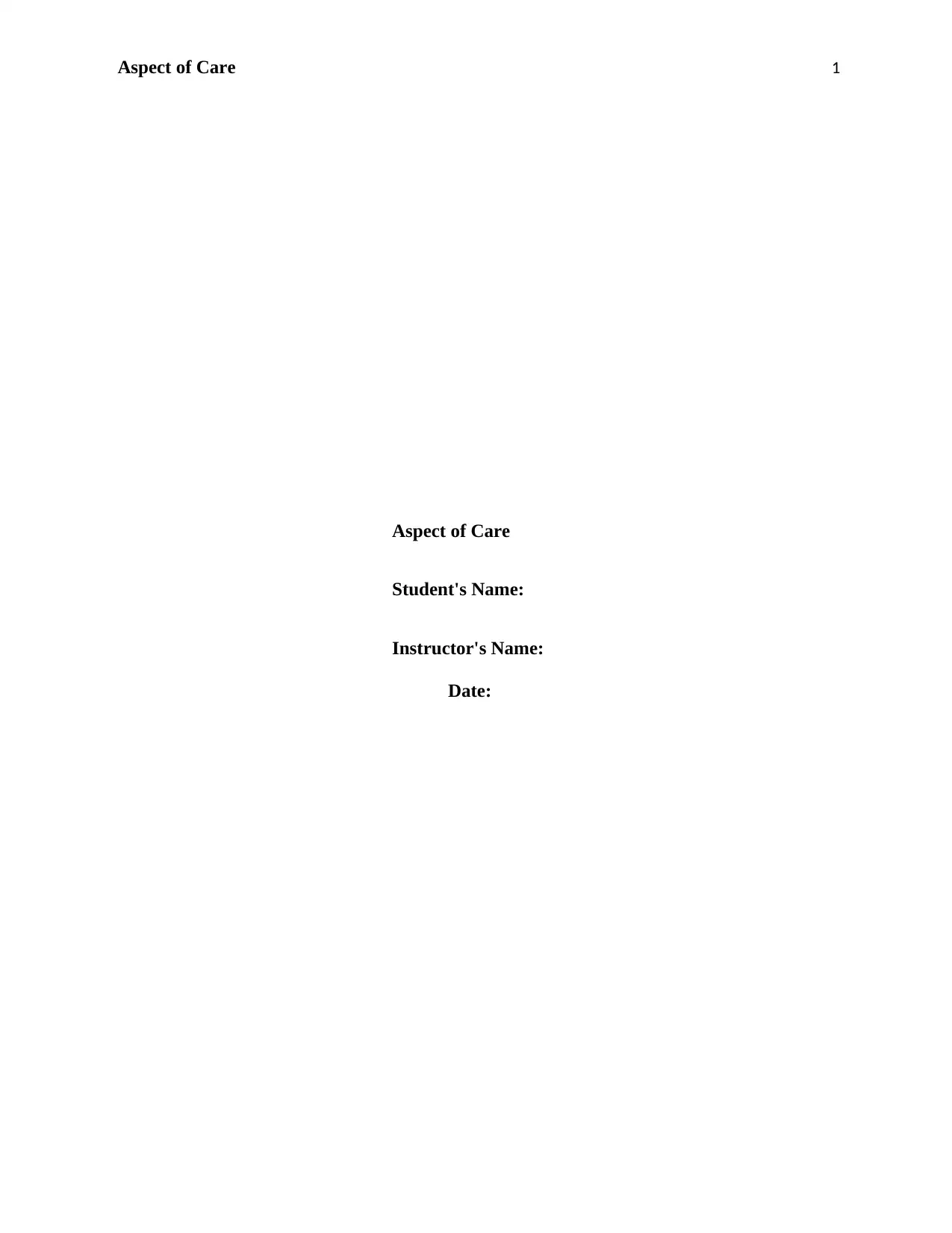
Aspect of Care 1
Aspect of Care
Student's Name:
Instructor's Name:
Date:
Aspect of Care
Student's Name:
Instructor's Name:
Date:
Secure Best Marks with AI Grader
Need help grading? Try our AI Grader for instant feedback on your assignments.
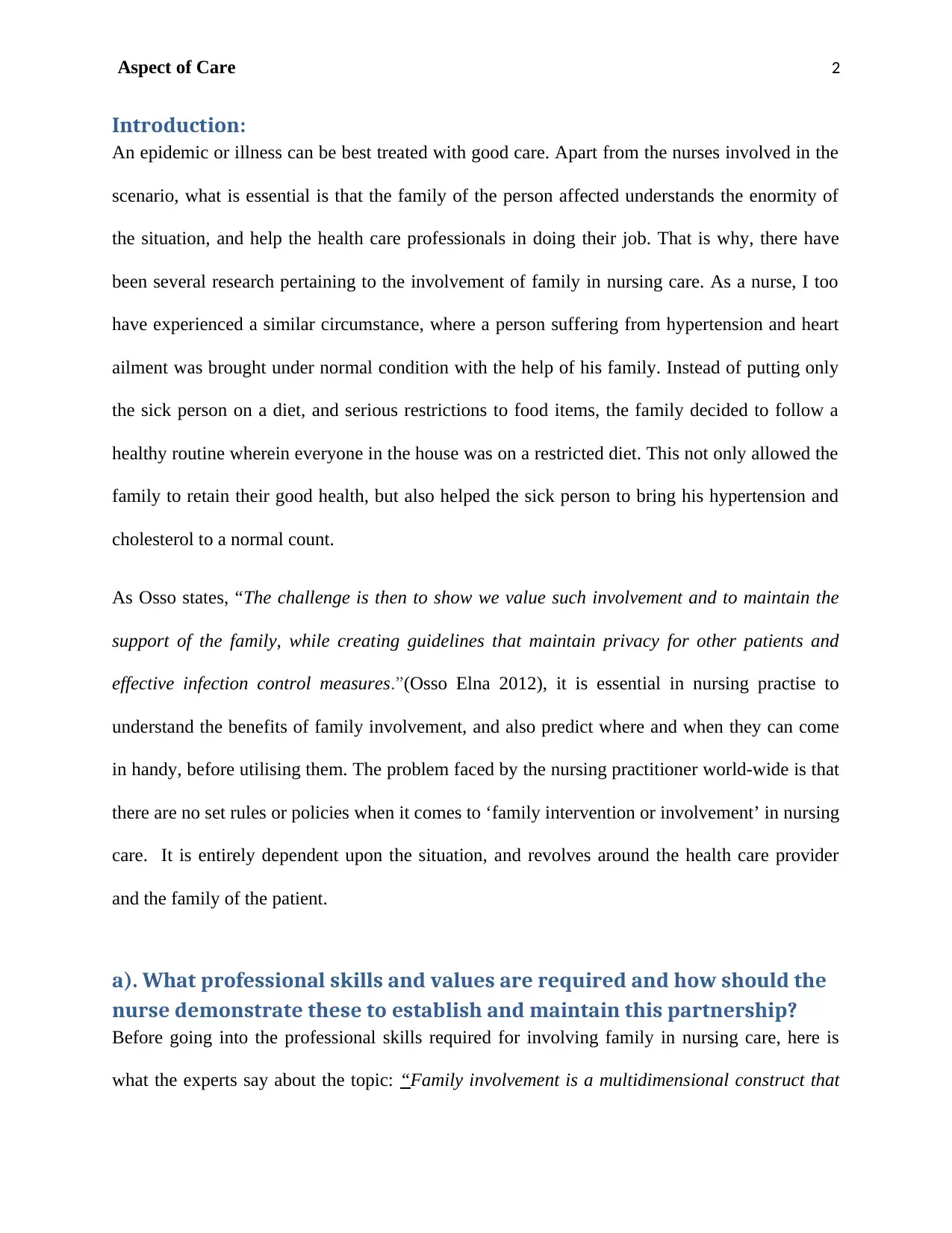
Aspect of Care 2
Introduction:
An epidemic or illness can be best treated with good care. Apart from the nurses involved in the
scenario, what is essential is that the family of the person affected understands the enormity of
the situation, and help the health care professionals in doing their job. That is why, there have
been several research pertaining to the involvement of family in nursing care. As a nurse, I too
have experienced a similar circumstance, where a person suffering from hypertension and heart
ailment was brought under normal condition with the help of his family. Instead of putting only
the sick person on a diet, and serious restrictions to food items, the family decided to follow a
healthy routine wherein everyone in the house was on a restricted diet. This not only allowed the
family to retain their good health, but also helped the sick person to bring his hypertension and
cholesterol to a normal count.
As Osso states, “The challenge is then to show we value such involvement and to maintain the
support of the family, while creating guidelines that maintain privacy for other patients and
effective infection control measures.”(Osso Elna 2012), it is essential in nursing practise to
understand the benefits of family involvement, and also predict where and when they can come
in handy, before utilising them. The problem faced by the nursing practitioner world-wide is that
there are no set rules or policies when it comes to ‘family intervention or involvement’ in nursing
care. It is entirely dependent upon the situation, and revolves around the health care provider
and the family of the patient.
a). What professional skills and values are required and how should the
nurse demonstrate these to establish and maintain this partnership?
Before going into the professional skills required for involving family in nursing care, here is
what the experts say about the topic: “Family involvement is a multidimensional construct that
Introduction:
An epidemic or illness can be best treated with good care. Apart from the nurses involved in the
scenario, what is essential is that the family of the person affected understands the enormity of
the situation, and help the health care professionals in doing their job. That is why, there have
been several research pertaining to the involvement of family in nursing care. As a nurse, I too
have experienced a similar circumstance, where a person suffering from hypertension and heart
ailment was brought under normal condition with the help of his family. Instead of putting only
the sick person on a diet, and serious restrictions to food items, the family decided to follow a
healthy routine wherein everyone in the house was on a restricted diet. This not only allowed the
family to retain their good health, but also helped the sick person to bring his hypertension and
cholesterol to a normal count.
As Osso states, “The challenge is then to show we value such involvement and to maintain the
support of the family, while creating guidelines that maintain privacy for other patients and
effective infection control measures.”(Osso Elna 2012), it is essential in nursing practise to
understand the benefits of family involvement, and also predict where and when they can come
in handy, before utilising them. The problem faced by the nursing practitioner world-wide is that
there are no set rules or policies when it comes to ‘family intervention or involvement’ in nursing
care. It is entirely dependent upon the situation, and revolves around the health care provider
and the family of the patient.
a). What professional skills and values are required and how should the
nurse demonstrate these to establish and maintain this partnership?
Before going into the professional skills required for involving family in nursing care, here is
what the experts say about the topic: “Family involvement is a multidimensional construct that
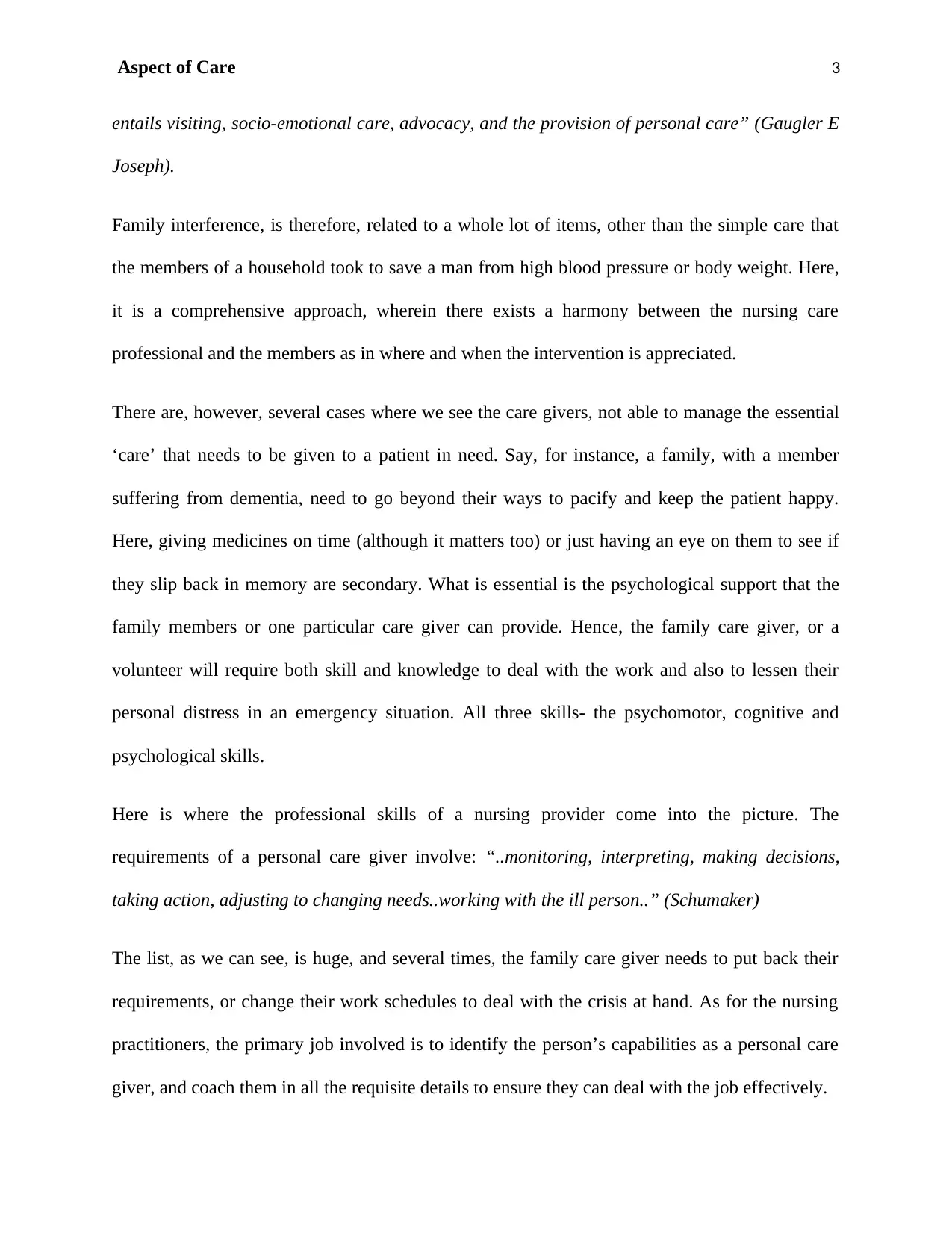
Aspect of Care 3
entails visiting, socio-emotional care, advocacy, and the provision of personal care” (Gaugler E
Joseph).
Family interference, is therefore, related to a whole lot of items, other than the simple care that
the members of a household took to save a man from high blood pressure or body weight. Here,
it is a comprehensive approach, wherein there exists a harmony between the nursing care
professional and the members as in where and when the intervention is appreciated.
There are, however, several cases where we see the care givers, not able to manage the essential
‘care’ that needs to be given to a patient in need. Say, for instance, a family, with a member
suffering from dementia, need to go beyond their ways to pacify and keep the patient happy.
Here, giving medicines on time (although it matters too) or just having an eye on them to see if
they slip back in memory are secondary. What is essential is the psychological support that the
family members or one particular care giver can provide. Hence, the family care giver, or a
volunteer will require both skill and knowledge to deal with the work and also to lessen their
personal distress in an emergency situation. All three skills- the psychomotor, cognitive and
psychological skills.
Here is where the professional skills of a nursing provider come into the picture. The
requirements of a personal care giver involve: “..monitoring, interpreting, making decisions,
taking action, adjusting to changing needs..working with the ill person..” (Schumaker)
The list, as we can see, is huge, and several times, the family care giver needs to put back their
requirements, or change their work schedules to deal with the crisis at hand. As for the nursing
practitioners, the primary job involved is to identify the person’s capabilities as a personal care
giver, and coach them in all the requisite details to ensure they can deal with the job effectively.
entails visiting, socio-emotional care, advocacy, and the provision of personal care” (Gaugler E
Joseph).
Family interference, is therefore, related to a whole lot of items, other than the simple care that
the members of a household took to save a man from high blood pressure or body weight. Here,
it is a comprehensive approach, wherein there exists a harmony between the nursing care
professional and the members as in where and when the intervention is appreciated.
There are, however, several cases where we see the care givers, not able to manage the essential
‘care’ that needs to be given to a patient in need. Say, for instance, a family, with a member
suffering from dementia, need to go beyond their ways to pacify and keep the patient happy.
Here, giving medicines on time (although it matters too) or just having an eye on them to see if
they slip back in memory are secondary. What is essential is the psychological support that the
family members or one particular care giver can provide. Hence, the family care giver, or a
volunteer will require both skill and knowledge to deal with the work and also to lessen their
personal distress in an emergency situation. All three skills- the psychomotor, cognitive and
psychological skills.
Here is where the professional skills of a nursing provider come into the picture. The
requirements of a personal care giver involve: “..monitoring, interpreting, making decisions,
taking action, adjusting to changing needs..working with the ill person..” (Schumaker)
The list, as we can see, is huge, and several times, the family care giver needs to put back their
requirements, or change their work schedules to deal with the crisis at hand. As for the nursing
practitioners, the primary job involved is to identify the person’s capabilities as a personal care
giver, and coach them in all the requisite details to ensure they can deal with the job effectively.
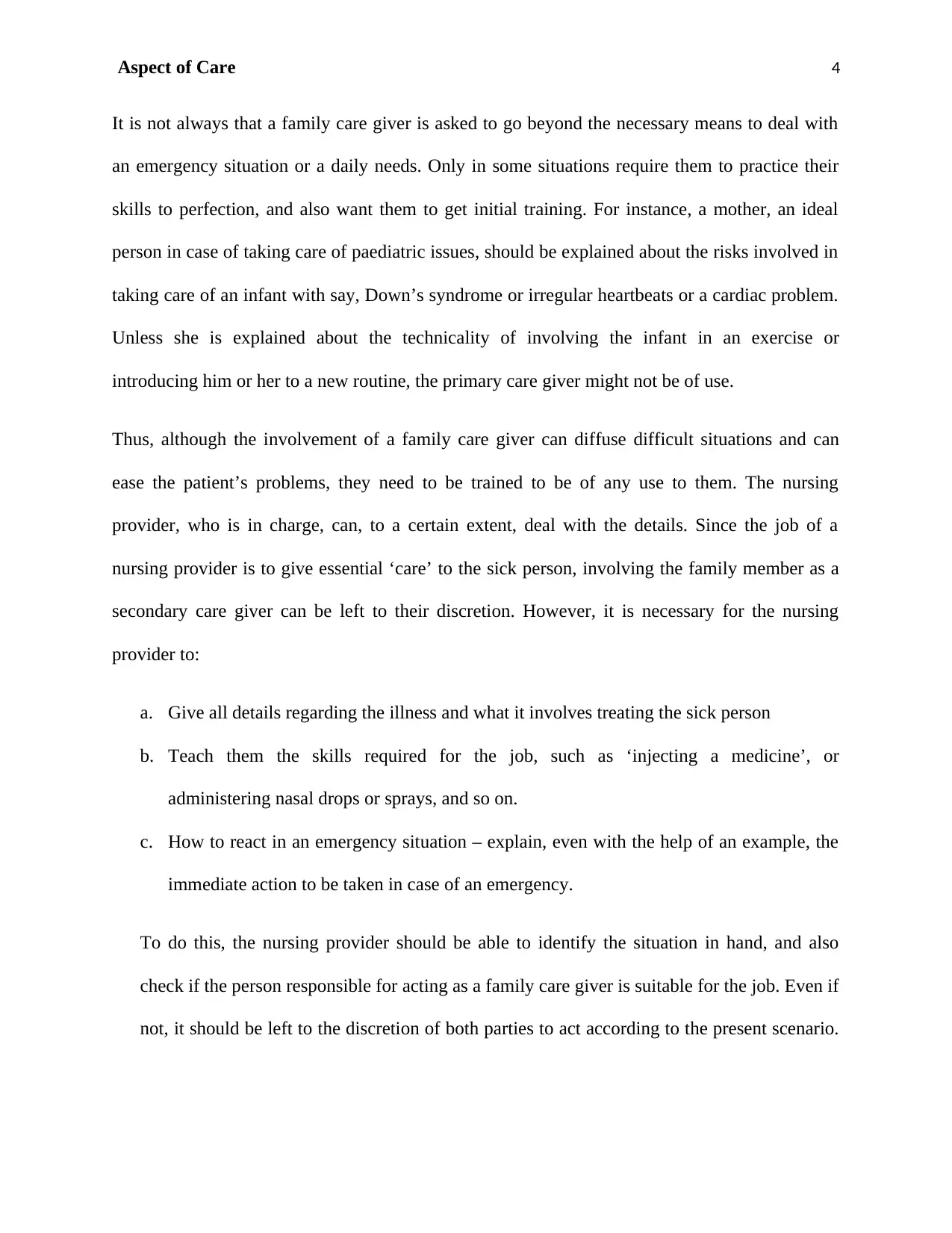
Aspect of Care 4
It is not always that a family care giver is asked to go beyond the necessary means to deal with
an emergency situation or a daily needs. Only in some situations require them to practice their
skills to perfection, and also want them to get initial training. For instance, a mother, an ideal
person in case of taking care of paediatric issues, should be explained about the risks involved in
taking care of an infant with say, Down’s syndrome or irregular heartbeats or a cardiac problem.
Unless she is explained about the technicality of involving the infant in an exercise or
introducing him or her to a new routine, the primary care giver might not be of use.
Thus, although the involvement of a family care giver can diffuse difficult situations and can
ease the patient’s problems, they need to be trained to be of any use to them. The nursing
provider, who is in charge, can, to a certain extent, deal with the details. Since the job of a
nursing provider is to give essential ‘care’ to the sick person, involving the family member as a
secondary care giver can be left to their discretion. However, it is necessary for the nursing
provider to:
a. Give all details regarding the illness and what it involves treating the sick person
b. Teach them the skills required for the job, such as ‘injecting a medicine’, or
administering nasal drops or sprays, and so on.
c. How to react in an emergency situation – explain, even with the help of an example, the
immediate action to be taken in case of an emergency.
To do this, the nursing provider should be able to identify the situation in hand, and also
check if the person responsible for acting as a family care giver is suitable for the job. Even if
not, it should be left to the discretion of both parties to act according to the present scenario.
It is not always that a family care giver is asked to go beyond the necessary means to deal with
an emergency situation or a daily needs. Only in some situations require them to practice their
skills to perfection, and also want them to get initial training. For instance, a mother, an ideal
person in case of taking care of paediatric issues, should be explained about the risks involved in
taking care of an infant with say, Down’s syndrome or irregular heartbeats or a cardiac problem.
Unless she is explained about the technicality of involving the infant in an exercise or
introducing him or her to a new routine, the primary care giver might not be of use.
Thus, although the involvement of a family care giver can diffuse difficult situations and can
ease the patient’s problems, they need to be trained to be of any use to them. The nursing
provider, who is in charge, can, to a certain extent, deal with the details. Since the job of a
nursing provider is to give essential ‘care’ to the sick person, involving the family member as a
secondary care giver can be left to their discretion. However, it is necessary for the nursing
provider to:
a. Give all details regarding the illness and what it involves treating the sick person
b. Teach them the skills required for the job, such as ‘injecting a medicine’, or
administering nasal drops or sprays, and so on.
c. How to react in an emergency situation – explain, even with the help of an example, the
immediate action to be taken in case of an emergency.
To do this, the nursing provider should be able to identify the situation in hand, and also
check if the person responsible for acting as a family care giver is suitable for the job. Even if
not, it should be left to the discretion of both parties to act according to the present scenario.
Secure Best Marks with AI Grader
Need help grading? Try our AI Grader for instant feedback on your assignments.
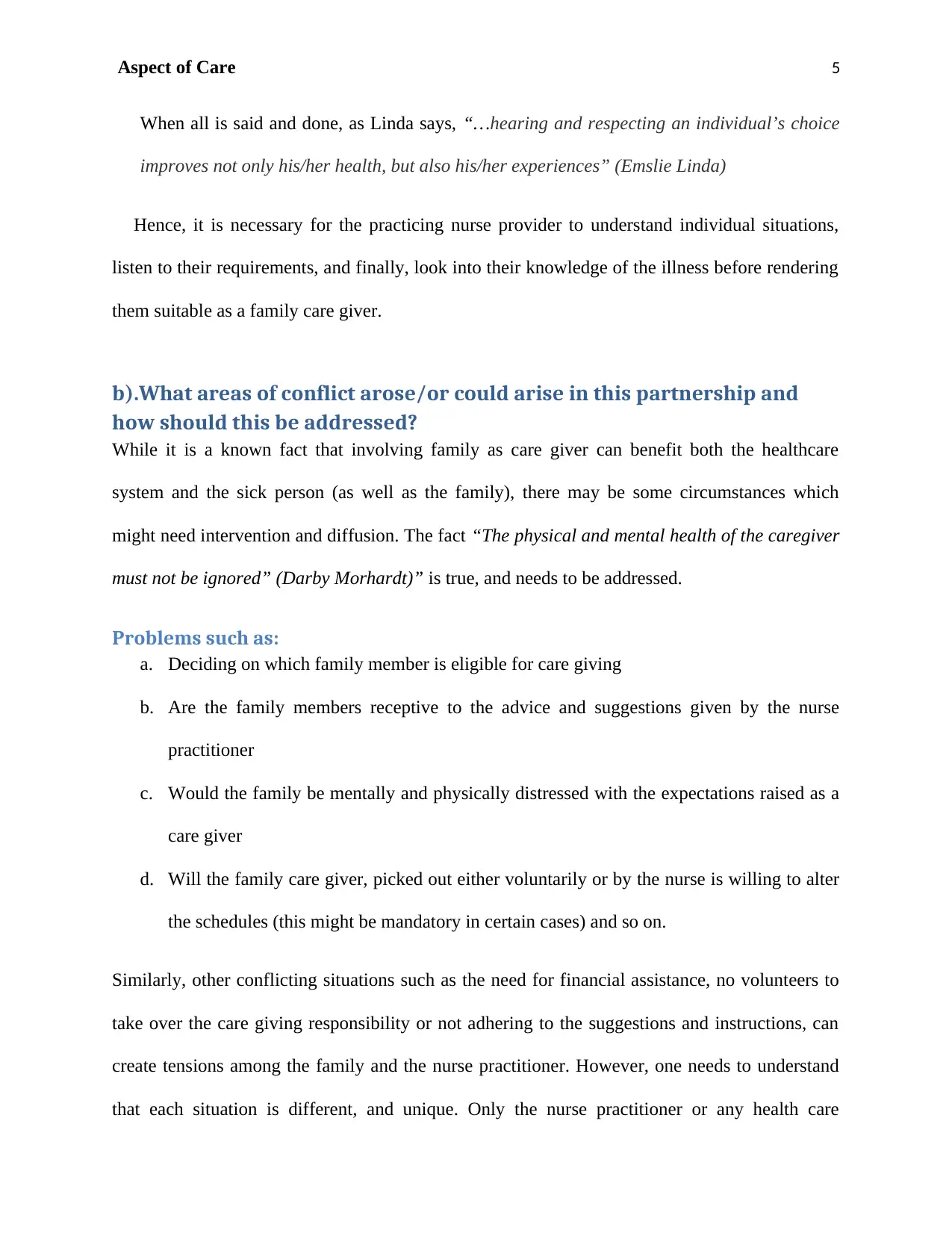
Aspect of Care 5
When all is said and done, as Linda says, “…hearing and respecting an individual’s choice
improves not only his/her health, but also his/her experiences” (Emslie Linda)
Hence, it is necessary for the practicing nurse provider to understand individual situations,
listen to their requirements, and finally, look into their knowledge of the illness before rendering
them suitable as a family care giver.
b).What areas of conflict arose/or could arise in this partnership and
how should this be addressed?
While it is a known fact that involving family as care giver can benefit both the healthcare
system and the sick person (as well as the family), there may be some circumstances which
might need intervention and diffusion. The fact “The physical and mental health of the caregiver
must not be ignored” (Darby Morhardt)” is true, and needs to be addressed.
Problems such as:
a. Deciding on which family member is eligible for care giving
b. Are the family members receptive to the advice and suggestions given by the nurse
practitioner
c. Would the family be mentally and physically distressed with the expectations raised as a
care giver
d. Will the family care giver, picked out either voluntarily or by the nurse is willing to alter
the schedules (this might be mandatory in certain cases) and so on.
Similarly, other conflicting situations such as the need for financial assistance, no volunteers to
take over the care giving responsibility or not adhering to the suggestions and instructions, can
create tensions among the family and the nurse practitioner. However, one needs to understand
that each situation is different, and unique. Only the nurse practitioner or any health care
When all is said and done, as Linda says, “…hearing and respecting an individual’s choice
improves not only his/her health, but also his/her experiences” (Emslie Linda)
Hence, it is necessary for the practicing nurse provider to understand individual situations,
listen to their requirements, and finally, look into their knowledge of the illness before rendering
them suitable as a family care giver.
b).What areas of conflict arose/or could arise in this partnership and
how should this be addressed?
While it is a known fact that involving family as care giver can benefit both the healthcare
system and the sick person (as well as the family), there may be some circumstances which
might need intervention and diffusion. The fact “The physical and mental health of the caregiver
must not be ignored” (Darby Morhardt)” is true, and needs to be addressed.
Problems such as:
a. Deciding on which family member is eligible for care giving
b. Are the family members receptive to the advice and suggestions given by the nurse
practitioner
c. Would the family be mentally and physically distressed with the expectations raised as a
care giver
d. Will the family care giver, picked out either voluntarily or by the nurse is willing to alter
the schedules (this might be mandatory in certain cases) and so on.
Similarly, other conflicting situations such as the need for financial assistance, no volunteers to
take over the care giving responsibility or not adhering to the suggestions and instructions, can
create tensions among the family and the nurse practitioner. However, one needs to understand
that each situation is different, and unique. Only the nurse practitioner or any health care
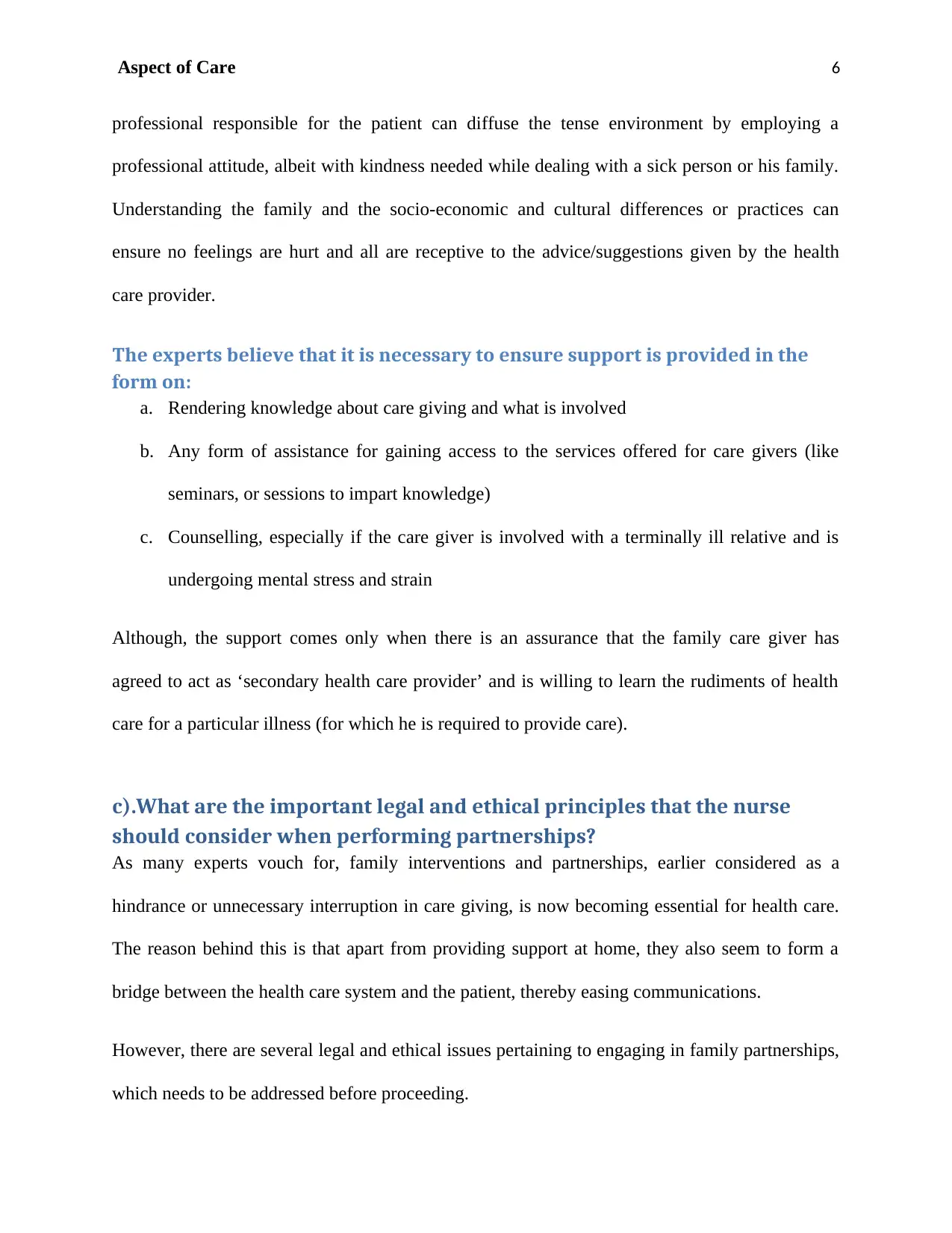
Aspect of Care 6
professional responsible for the patient can diffuse the tense environment by employing a
professional attitude, albeit with kindness needed while dealing with a sick person or his family.
Understanding the family and the socio-economic and cultural differences or practices can
ensure no feelings are hurt and all are receptive to the advice/suggestions given by the health
care provider.
The experts believe that it is necessary to ensure support is provided in the
form on:
a. Rendering knowledge about care giving and what is involved
b. Any form of assistance for gaining access to the services offered for care givers (like
seminars, or sessions to impart knowledge)
c. Counselling, especially if the care giver is involved with a terminally ill relative and is
undergoing mental stress and strain
Although, the support comes only when there is an assurance that the family care giver has
agreed to act as ‘secondary health care provider’ and is willing to learn the rudiments of health
care for a particular illness (for which he is required to provide care).
c).What are the important legal and ethical principles that the nurse
should consider when performing partnerships?
As many experts vouch for, family interventions and partnerships, earlier considered as a
hindrance or unnecessary interruption in care giving, is now becoming essential for health care.
The reason behind this is that apart from providing support at home, they also seem to form a
bridge between the health care system and the patient, thereby easing communications.
However, there are several legal and ethical issues pertaining to engaging in family partnerships,
which needs to be addressed before proceeding.
professional responsible for the patient can diffuse the tense environment by employing a
professional attitude, albeit with kindness needed while dealing with a sick person or his family.
Understanding the family and the socio-economic and cultural differences or practices can
ensure no feelings are hurt and all are receptive to the advice/suggestions given by the health
care provider.
The experts believe that it is necessary to ensure support is provided in the
form on:
a. Rendering knowledge about care giving and what is involved
b. Any form of assistance for gaining access to the services offered for care givers (like
seminars, or sessions to impart knowledge)
c. Counselling, especially if the care giver is involved with a terminally ill relative and is
undergoing mental stress and strain
Although, the support comes only when there is an assurance that the family care giver has
agreed to act as ‘secondary health care provider’ and is willing to learn the rudiments of health
care for a particular illness (for which he is required to provide care).
c).What are the important legal and ethical principles that the nurse
should consider when performing partnerships?
As many experts vouch for, family interventions and partnerships, earlier considered as a
hindrance or unnecessary interruption in care giving, is now becoming essential for health care.
The reason behind this is that apart from providing support at home, they also seem to form a
bridge between the health care system and the patient, thereby easing communications.
However, there are several legal and ethical issues pertaining to engaging in family partnerships,
which needs to be addressed before proceeding.
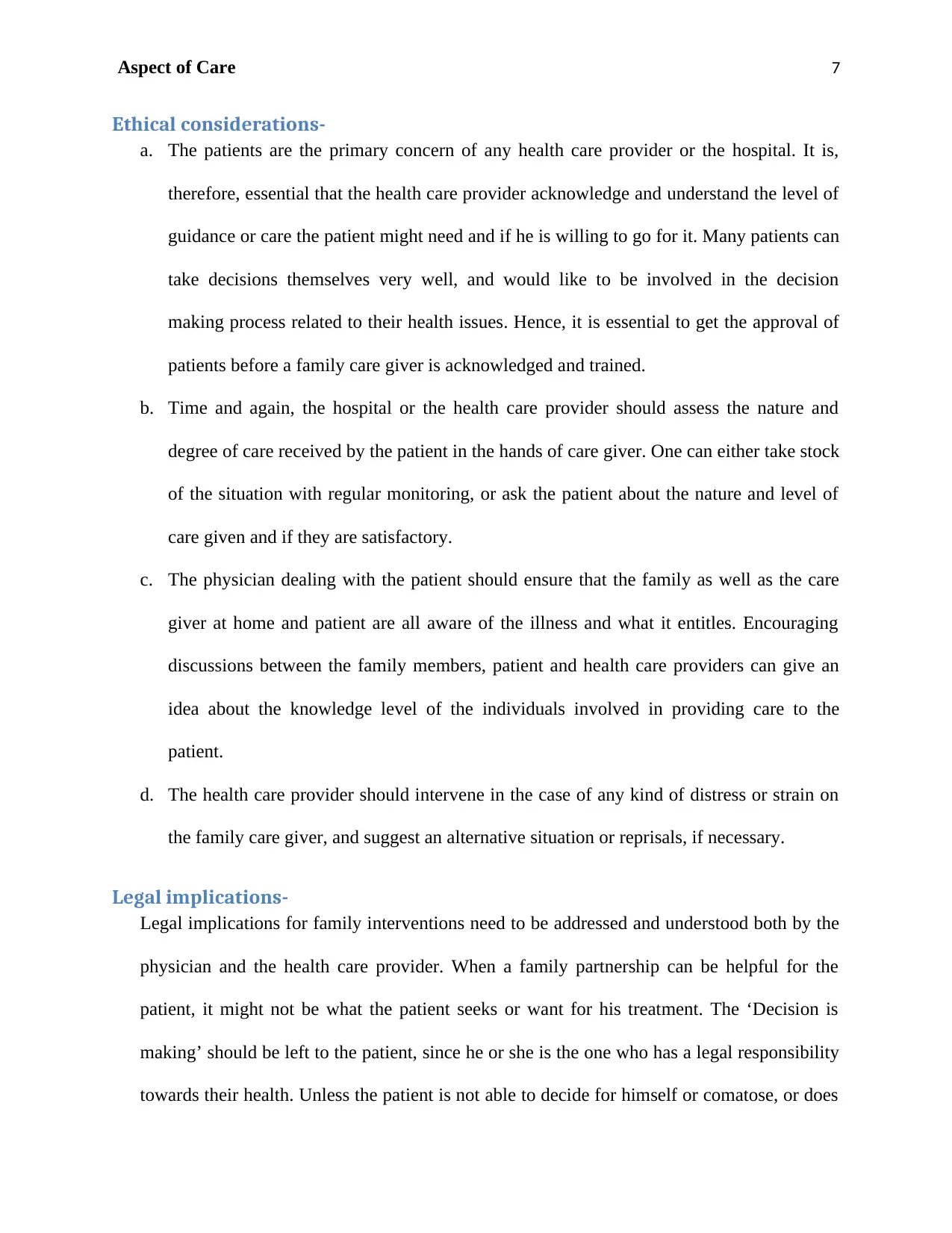
Aspect of Care 7
Ethical considerations-
a. The patients are the primary concern of any health care provider or the hospital. It is,
therefore, essential that the health care provider acknowledge and understand the level of
guidance or care the patient might need and if he is willing to go for it. Many patients can
take decisions themselves very well, and would like to be involved in the decision
making process related to their health issues. Hence, it is essential to get the approval of
patients before a family care giver is acknowledged and trained.
b. Time and again, the hospital or the health care provider should assess the nature and
degree of care received by the patient in the hands of care giver. One can either take stock
of the situation with regular monitoring, or ask the patient about the nature and level of
care given and if they are satisfactory.
c. The physician dealing with the patient should ensure that the family as well as the care
giver at home and patient are all aware of the illness and what it entitles. Encouraging
discussions between the family members, patient and health care providers can give an
idea about the knowledge level of the individuals involved in providing care to the
patient.
d. The health care provider should intervene in the case of any kind of distress or strain on
the family care giver, and suggest an alternative situation or reprisals, if necessary.
Legal implications-
Legal implications for family interventions need to be addressed and understood both by the
physician and the health care provider. When a family partnership can be helpful for the
patient, it might not be what the patient seeks or want for his treatment. The ‘Decision is
making’ should be left to the patient, since he or she is the one who has a legal responsibility
towards their health. Unless the patient is not able to decide for himself or comatose, or does
Ethical considerations-
a. The patients are the primary concern of any health care provider or the hospital. It is,
therefore, essential that the health care provider acknowledge and understand the level of
guidance or care the patient might need and if he is willing to go for it. Many patients can
take decisions themselves very well, and would like to be involved in the decision
making process related to their health issues. Hence, it is essential to get the approval of
patients before a family care giver is acknowledged and trained.
b. Time and again, the hospital or the health care provider should assess the nature and
degree of care received by the patient in the hands of care giver. One can either take stock
of the situation with regular monitoring, or ask the patient about the nature and level of
care given and if they are satisfactory.
c. The physician dealing with the patient should ensure that the family as well as the care
giver at home and patient are all aware of the illness and what it entitles. Encouraging
discussions between the family members, patient and health care providers can give an
idea about the knowledge level of the individuals involved in providing care to the
patient.
d. The health care provider should intervene in the case of any kind of distress or strain on
the family care giver, and suggest an alternative situation or reprisals, if necessary.
Legal implications-
Legal implications for family interventions need to be addressed and understood both by the
physician and the health care provider. When a family partnership can be helpful for the
patient, it might not be what the patient seeks or want for his treatment. The ‘Decision is
making’ should be left to the patient, since he or she is the one who has a legal responsibility
towards their health. Unless the patient is not able to decide for himself or comatose, or does
Paraphrase This Document
Need a fresh take? Get an instant paraphrase of this document with our AI Paraphraser
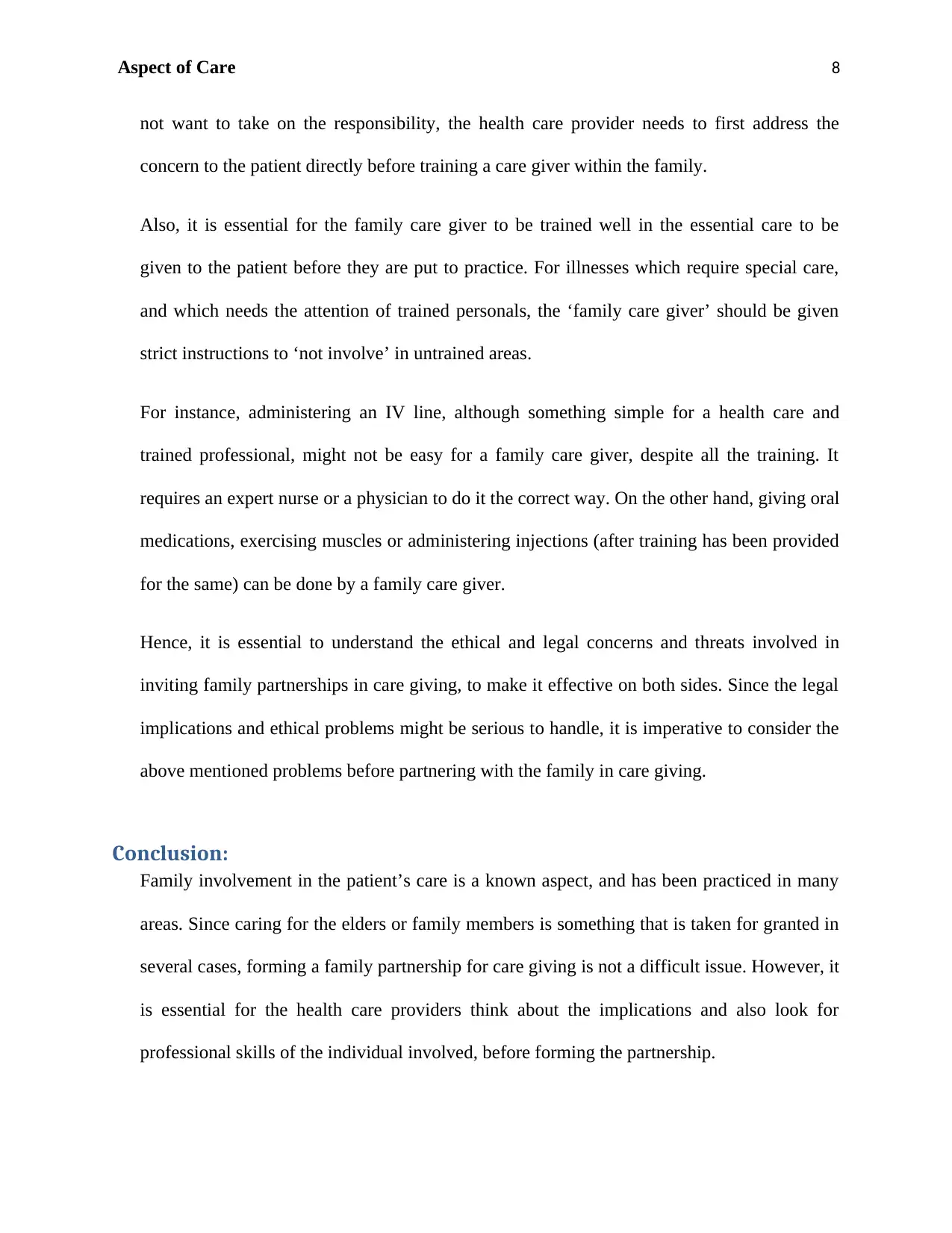
Aspect of Care 8
not want to take on the responsibility, the health care provider needs to first address the
concern to the patient directly before training a care giver within the family.
Also, it is essential for the family care giver to be trained well in the essential care to be
given to the patient before they are put to practice. For illnesses which require special care,
and which needs the attention of trained personals, the ‘family care giver’ should be given
strict instructions to ‘not involve’ in untrained areas.
For instance, administering an IV line, although something simple for a health care and
trained professional, might not be easy for a family care giver, despite all the training. It
requires an expert nurse or a physician to do it the correct way. On the other hand, giving oral
medications, exercising muscles or administering injections (after training has been provided
for the same) can be done by a family care giver.
Hence, it is essential to understand the ethical and legal concerns and threats involved in
inviting family partnerships in care giving, to make it effective on both sides. Since the legal
implications and ethical problems might be serious to handle, it is imperative to consider the
above mentioned problems before partnering with the family in care giving.
Conclusion:
Family involvement in the patient’s care is a known aspect, and has been practiced in many
areas. Since caring for the elders or family members is something that is taken for granted in
several cases, forming a family partnership for care giving is not a difficult issue. However, it
is essential for the health care providers think about the implications and also look for
professional skills of the individual involved, before forming the partnership.
not want to take on the responsibility, the health care provider needs to first address the
concern to the patient directly before training a care giver within the family.
Also, it is essential for the family care giver to be trained well in the essential care to be
given to the patient before they are put to practice. For illnesses which require special care,
and which needs the attention of trained personals, the ‘family care giver’ should be given
strict instructions to ‘not involve’ in untrained areas.
For instance, administering an IV line, although something simple for a health care and
trained professional, might not be easy for a family care giver, despite all the training. It
requires an expert nurse or a physician to do it the correct way. On the other hand, giving oral
medications, exercising muscles or administering injections (after training has been provided
for the same) can be done by a family care giver.
Hence, it is essential to understand the ethical and legal concerns and threats involved in
inviting family partnerships in care giving, to make it effective on both sides. Since the legal
implications and ethical problems might be serious to handle, it is imperative to consider the
above mentioned problems before partnering with the family in care giving.
Conclusion:
Family involvement in the patient’s care is a known aspect, and has been practiced in many
areas. Since caring for the elders or family members is something that is taken for granted in
several cases, forming a family partnership for care giving is not a difficult issue. However, it
is essential for the health care providers think about the implications and also look for
professional skills of the individual involved, before forming the partnership.
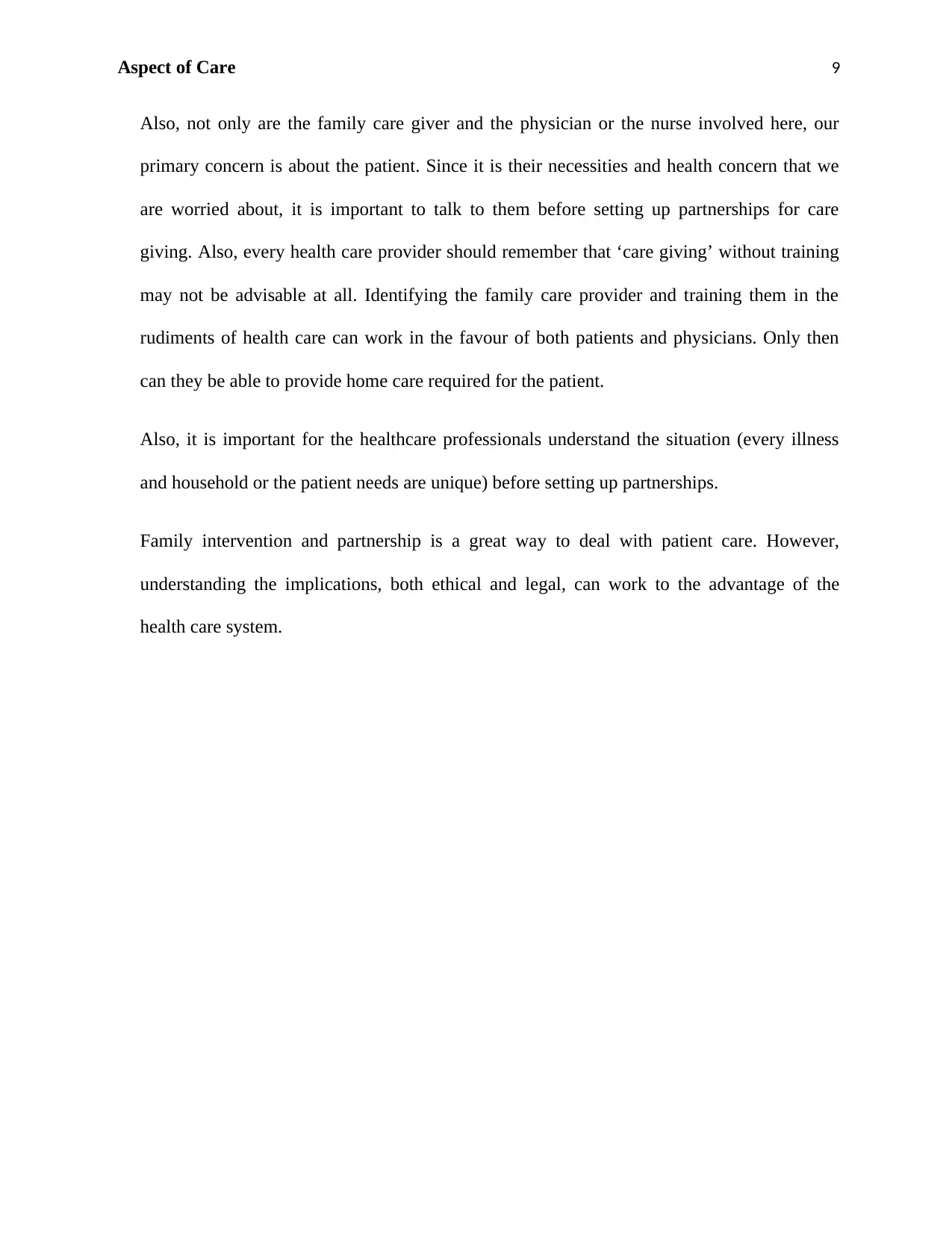
Aspect of Care 9
Also, not only are the family care giver and the physician or the nurse involved here, our
primary concern is about the patient. Since it is their necessities and health concern that we
are worried about, it is important to talk to them before setting up partnerships for care
giving. Also, every health care provider should remember that ‘care giving’ without training
may not be advisable at all. Identifying the family care provider and training them in the
rudiments of health care can work in the favour of both patients and physicians. Only then
can they be able to provide home care required for the patient.
Also, it is important for the healthcare professionals understand the situation (every illness
and household or the patient needs are unique) before setting up partnerships.
Family intervention and partnership is a great way to deal with patient care. However,
understanding the implications, both ethical and legal, can work to the advantage of the
health care system.
Also, not only are the family care giver and the physician or the nurse involved here, our
primary concern is about the patient. Since it is their necessities and health concern that we
are worried about, it is important to talk to them before setting up partnerships for care
giving. Also, every health care provider should remember that ‘care giving’ without training
may not be advisable at all. Identifying the family care provider and training them in the
rudiments of health care can work in the favour of both patients and physicians. Only then
can they be able to provide home care required for the patient.
Also, it is important for the healthcare professionals understand the situation (every illness
and household or the patient needs are unique) before setting up partnerships.
Family intervention and partnership is a great way to deal with patient care. However,
understanding the implications, both ethical and legal, can work to the advantage of the
health care system.
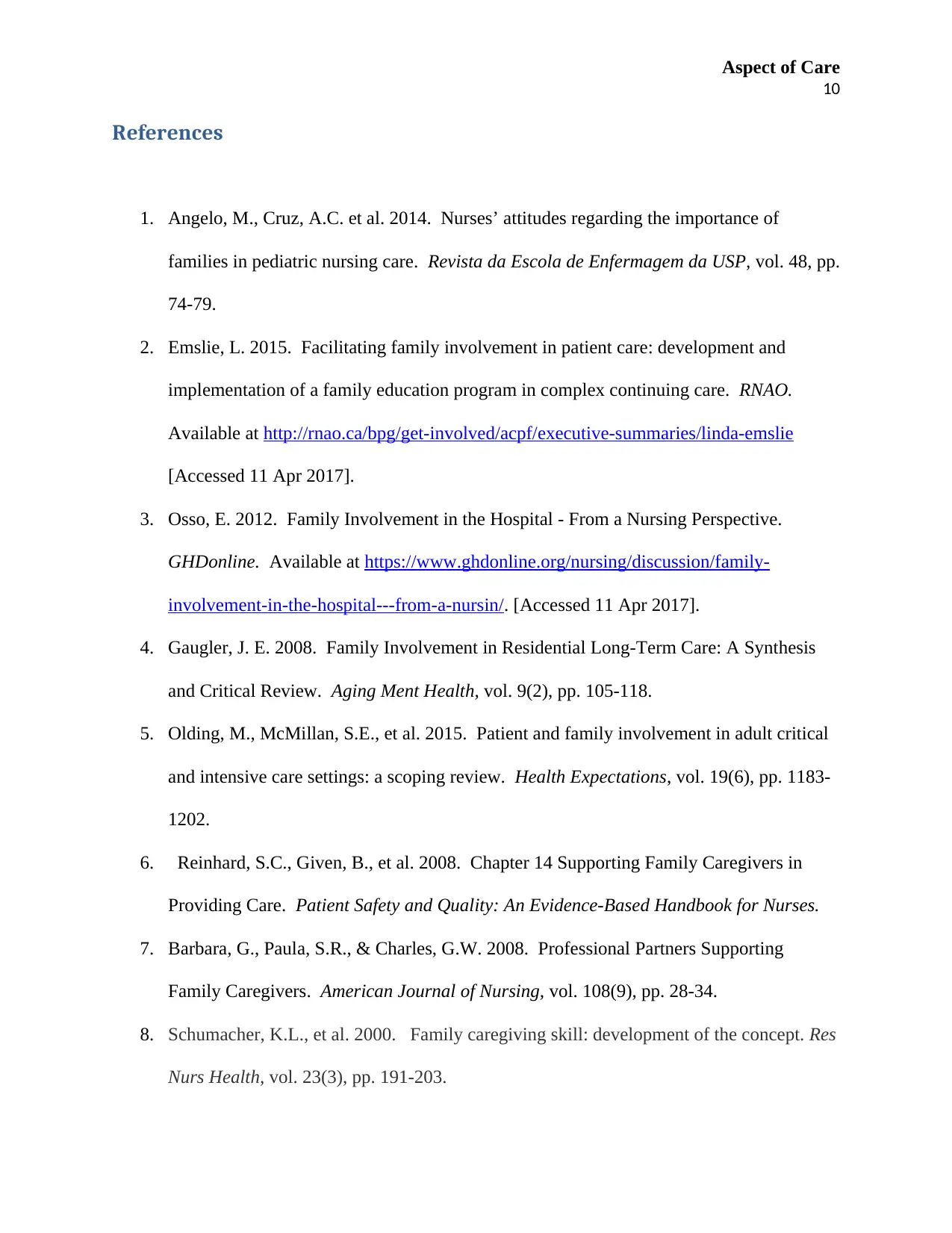
Aspect of Care
10
References
1. Angelo, M., Cruz, A.C. et al. 2014. Nurses’ attitudes regarding the importance of
families in pediatric nursing care. Revista da Escola de Enfermagem da USP, vol. 48, pp.
74-79.
2. Emslie, L. 2015. Facilitating family involvement in patient care: development and
implementation of a family education program in complex continuing care. RNAO.
Available at http://rnao.ca/bpg/get-involved/acpf/executive-summaries/linda-emslie
[Accessed 11 Apr 2017].
3. Osso, E. 2012. Family Involvement in the Hospital - From a Nursing Perspective.
GHDonline. Available at https://www.ghdonline.org/nursing/discussion/family-
involvement-in-the-hospital---from-a-nursin/. [Accessed 11 Apr 2017].
4. Gaugler, J. E. 2008. Family Involvement in Residential Long-Term Care: A Synthesis
and Critical Review. Aging Ment Health, vol. 9(2), pp. 105-118.
5. Olding, M., McMillan, S.E., et al. 2015. Patient and family involvement in adult critical
and intensive care settings: a scoping review. Health Expectations, vol. 19(6), pp. 1183-
1202.
6. Reinhard, S.C., Given, B., et al. 2008. Chapter 14 Supporting Family Caregivers in
Providing Care. Patient Safety and Quality: An Evidence-Based Handbook for Nurses.
7. Barbara, G., Paula, S.R., & Charles, G.W. 2008. Professional Partners Supporting
Family Caregivers. American Journal of Nursing, vol. 108(9), pp. 28-34.
8. Schumacher, K.L., et al. 2000. Family caregiving skill: development of the concept. Res
Nurs Health, vol. 23(3), pp. 191-203.
10
References
1. Angelo, M., Cruz, A.C. et al. 2014. Nurses’ attitudes regarding the importance of
families in pediatric nursing care. Revista da Escola de Enfermagem da USP, vol. 48, pp.
74-79.
2. Emslie, L. 2015. Facilitating family involvement in patient care: development and
implementation of a family education program in complex continuing care. RNAO.
Available at http://rnao.ca/bpg/get-involved/acpf/executive-summaries/linda-emslie
[Accessed 11 Apr 2017].
3. Osso, E. 2012. Family Involvement in the Hospital - From a Nursing Perspective.
GHDonline. Available at https://www.ghdonline.org/nursing/discussion/family-
involvement-in-the-hospital---from-a-nursin/. [Accessed 11 Apr 2017].
4. Gaugler, J. E. 2008. Family Involvement in Residential Long-Term Care: A Synthesis
and Critical Review. Aging Ment Health, vol. 9(2), pp. 105-118.
5. Olding, M., McMillan, S.E., et al. 2015. Patient and family involvement in adult critical
and intensive care settings: a scoping review. Health Expectations, vol. 19(6), pp. 1183-
1202.
6. Reinhard, S.C., Given, B., et al. 2008. Chapter 14 Supporting Family Caregivers in
Providing Care. Patient Safety and Quality: An Evidence-Based Handbook for Nurses.
7. Barbara, G., Paula, S.R., & Charles, G.W. 2008. Professional Partners Supporting
Family Caregivers. American Journal of Nursing, vol. 108(9), pp. 28-34.
8. Schumacher, K.L., et al. 2000. Family caregiving skill: development of the concept. Res
Nurs Health, vol. 23(3), pp. 191-203.
Secure Best Marks with AI Grader
Need help grading? Try our AI Grader for instant feedback on your assignments.
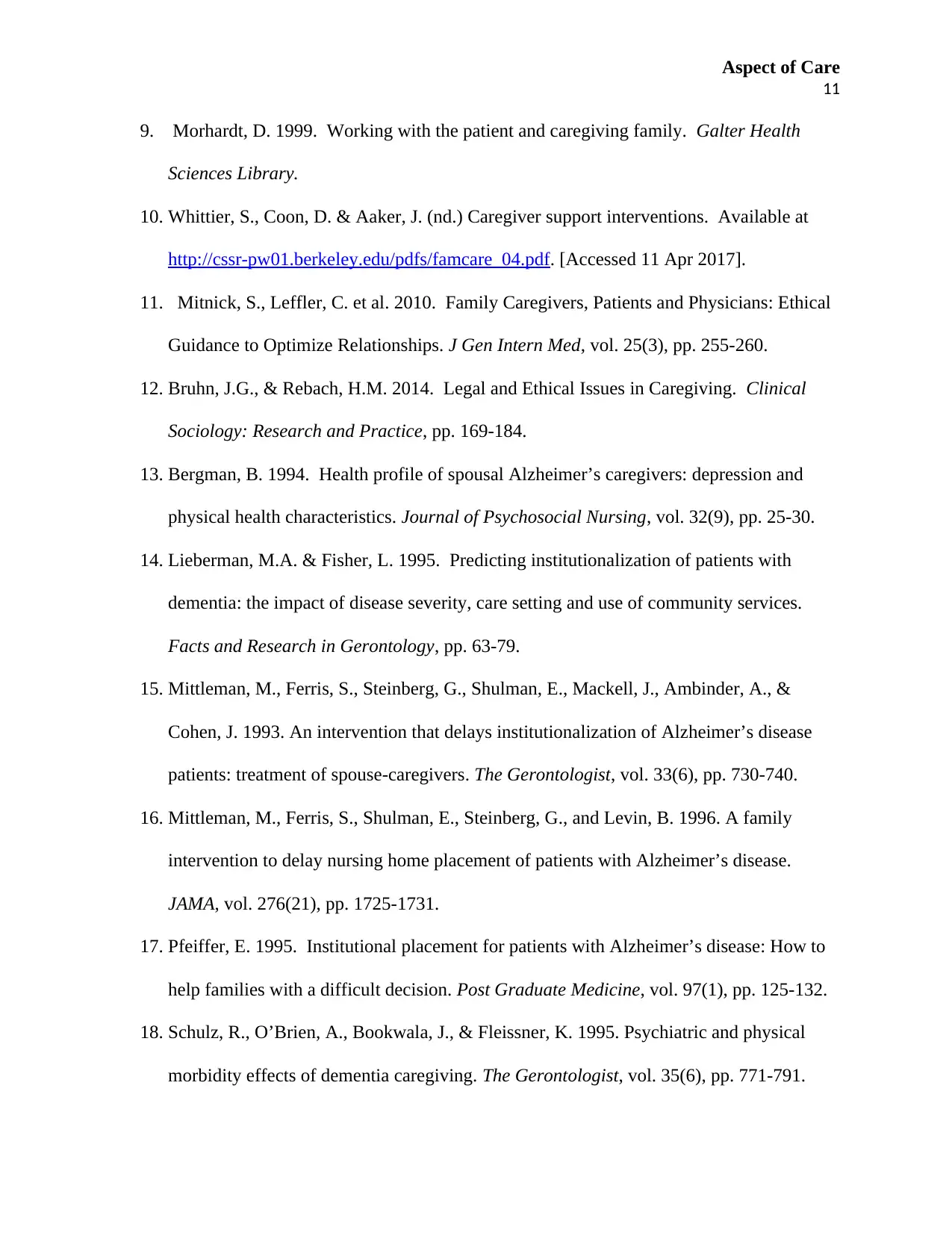
Aspect of Care
11
9. Morhardt, D. 1999. Working with the patient and caregiving family. Galter Health
Sciences Library.
10. Whittier, S., Coon, D. & Aaker, J. (nd.) Caregiver support interventions. Available at
http://cssr-pw01.berkeley.edu/pdfs/famcare_04.pdf. [Accessed 11 Apr 2017].
11. Mitnick, S., Leffler, C. et al. 2010. Family Caregivers, Patients and Physicians: Ethical
Guidance to Optimize Relationships. J Gen Intern Med, vol. 25(3), pp. 255-260.
12. Bruhn, J.G., & Rebach, H.M. 2014. Legal and Ethical Issues in Caregiving. Clinical
Sociology: Research and Practice, pp. 169-184.
13. Bergman, B. 1994. Health profile of spousal Alzheimer’s caregivers: depression and
physical health characteristics. Journal of Psychosocial Nursing, vol. 32(9), pp. 25-30.
14. Lieberman, M.A. & Fisher, L. 1995. Predicting institutionalization of patients with
dementia: the impact of disease severity, care setting and use of community services.
Facts and Research in Gerontology, pp. 63-79.
15. Mittleman, M., Ferris, S., Steinberg, G., Shulman, E., Mackell, J., Ambinder, A., &
Cohen, J. 1993. An intervention that delays institutionalization of Alzheimer’s disease
patients: treatment of spouse-caregivers. The Gerontologist, vol. 33(6), pp. 730-740.
16. Mittleman, M., Ferris, S., Shulman, E., Steinberg, G., and Levin, B. 1996. A family
intervention to delay nursing home placement of patients with Alzheimer’s disease.
JAMA, vol. 276(21), pp. 1725-1731.
17. Pfeiffer, E. 1995. Institutional placement for patients with Alzheimer’s disease: How to
help families with a difficult decision. Post Graduate Medicine, vol. 97(1), pp. 125-132.
18. Schulz, R., O’Brien, A., Bookwala, J., & Fleissner, K. 1995. Psychiatric and physical
morbidity effects of dementia caregiving. The Gerontologist, vol. 35(6), pp. 771-791.
11
9. Morhardt, D. 1999. Working with the patient and caregiving family. Galter Health
Sciences Library.
10. Whittier, S., Coon, D. & Aaker, J. (nd.) Caregiver support interventions. Available at
http://cssr-pw01.berkeley.edu/pdfs/famcare_04.pdf. [Accessed 11 Apr 2017].
11. Mitnick, S., Leffler, C. et al. 2010. Family Caregivers, Patients and Physicians: Ethical
Guidance to Optimize Relationships. J Gen Intern Med, vol. 25(3), pp. 255-260.
12. Bruhn, J.G., & Rebach, H.M. 2014. Legal and Ethical Issues in Caregiving. Clinical
Sociology: Research and Practice, pp. 169-184.
13. Bergman, B. 1994. Health profile of spousal Alzheimer’s caregivers: depression and
physical health characteristics. Journal of Psychosocial Nursing, vol. 32(9), pp. 25-30.
14. Lieberman, M.A. & Fisher, L. 1995. Predicting institutionalization of patients with
dementia: the impact of disease severity, care setting and use of community services.
Facts and Research in Gerontology, pp. 63-79.
15. Mittleman, M., Ferris, S., Steinberg, G., Shulman, E., Mackell, J., Ambinder, A., &
Cohen, J. 1993. An intervention that delays institutionalization of Alzheimer’s disease
patients: treatment of spouse-caregivers. The Gerontologist, vol. 33(6), pp. 730-740.
16. Mittleman, M., Ferris, S., Shulman, E., Steinberg, G., and Levin, B. 1996. A family
intervention to delay nursing home placement of patients with Alzheimer’s disease.
JAMA, vol. 276(21), pp. 1725-1731.
17. Pfeiffer, E. 1995. Institutional placement for patients with Alzheimer’s disease: How to
help families with a difficult decision. Post Graduate Medicine, vol. 97(1), pp. 125-132.
18. Schulz, R., O’Brien, A., Bookwala, J., & Fleissner, K. 1995. Psychiatric and physical
morbidity effects of dementia caregiving. The Gerontologist, vol. 35(6), pp. 771-791.
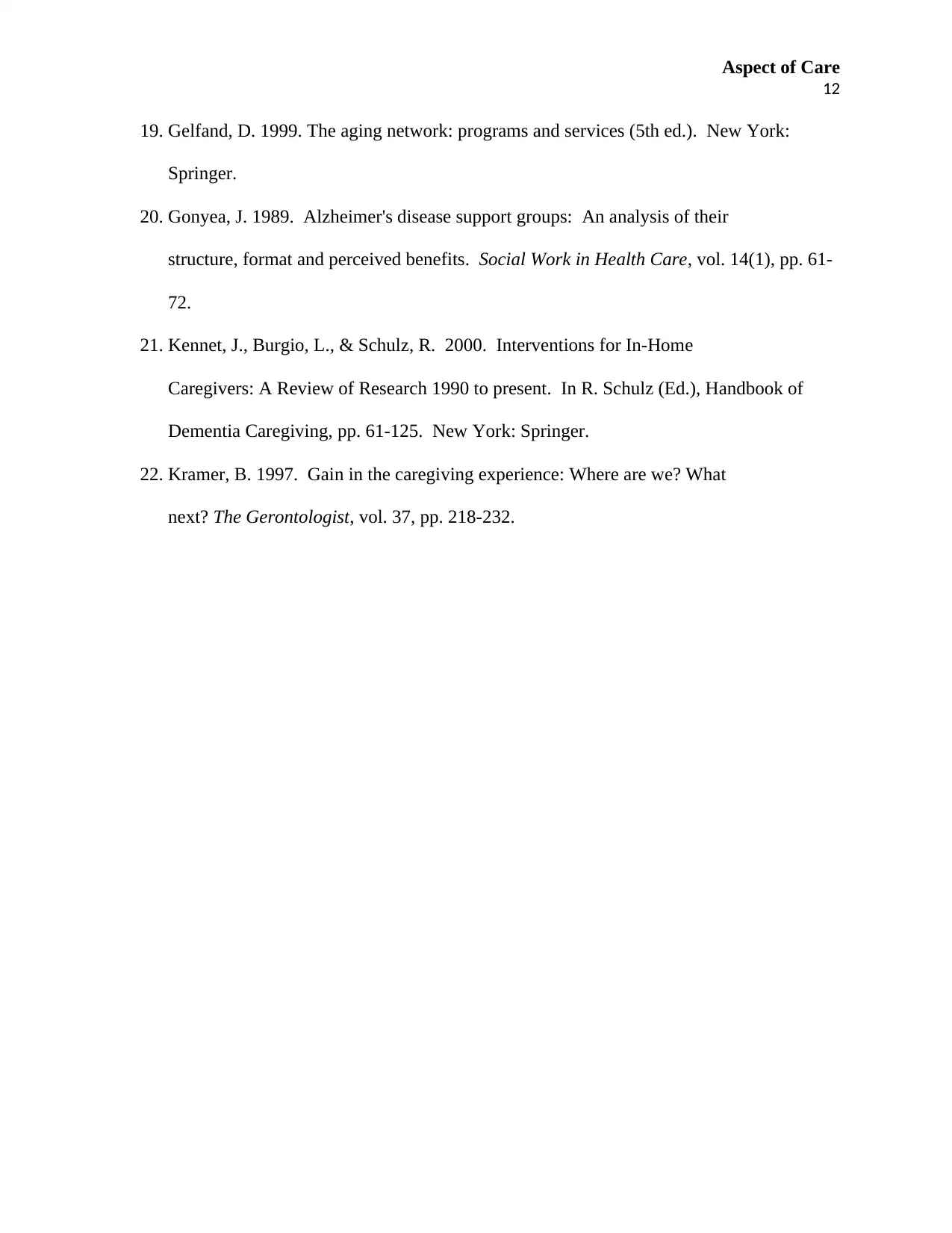
Aspect of Care
12
19. Gelfand, D. 1999. The aging network: programs and services (5th ed.). New York:
Springer.
20. Gonyea, J. 1989. Alzheimer's disease support groups: An analysis of their
structure, format and perceived benefits. Social Work in Health Care, vol. 14(1), pp. 61-
72.
21. Kennet, J., Burgio, L., & Schulz, R. 2000. Interventions for In-Home
Caregivers: A Review of Research 1990 to present. In R. Schulz (Ed.), Handbook of
Dementia Caregiving, pp. 61-125. New York: Springer.
22. Kramer, B. 1997. Gain in the caregiving experience: Where are we? What
next? The Gerontologist, vol. 37, pp. 218-232.
12
19. Gelfand, D. 1999. The aging network: programs and services (5th ed.). New York:
Springer.
20. Gonyea, J. 1989. Alzheimer's disease support groups: An analysis of their
structure, format and perceived benefits. Social Work in Health Care, vol. 14(1), pp. 61-
72.
21. Kennet, J., Burgio, L., & Schulz, R. 2000. Interventions for In-Home
Caregivers: A Review of Research 1990 to present. In R. Schulz (Ed.), Handbook of
Dementia Caregiving, pp. 61-125. New York: Springer.
22. Kramer, B. 1997. Gain in the caregiving experience: Where are we? What
next? The Gerontologist, vol. 37, pp. 218-232.
1 out of 12
Related Documents
Your All-in-One AI-Powered Toolkit for Academic Success.
+13062052269
info@desklib.com
Available 24*7 on WhatsApp / Email
![[object Object]](/_next/static/media/star-bottom.7253800d.svg)
Unlock your academic potential
© 2024 | Zucol Services PVT LTD | All rights reserved.




